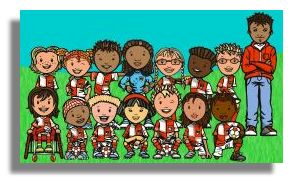Well why not use this video clip that I was alerted to via Twitter @i100 this morning!
Watch how the portrait of a woman's face has changed over 800 years of painting
- Give children target language name cards- 3 per child. Practise and use the target language names of course and then play the video and ask the children to raise the name cards when they see a face that they think suits the target language name.
- Now ask the children to work in groups of four and create 12 faces -using facial expressions for the 12 name cards they hold between them. They must introduce themselves using a full target language sentence.
- Ask the children to find portraits of characters through the ages that they can label with their target language name phrases and then create their own short videos with portraits and names
- Practising describing eye and and hair colour?Well then ask the children to write as many eye and hair colours phrases as they can on a piece of paper. The children cut the phrases into phrase strips and one child goes first on the table or in the group to share their phrases with their classmates.
- Ask the children to read out the phrase they hold (it could be an eye colour or a hair colour) and tell the group what they think the phrase is in English . Does the person who wrote the phrase agree?
- Now play the video and ask the children to watch for a portrait ,where they can see or identify the eye colour or hair colour phrase strip they are holding.They must raise the strip in the air to acknowledge this . Pause the video every so often and see what phrases the children are holding up. Are they all correct ? Do they match the portrait?
- Increase the challenge by giving the children pre-prepared phrases which have an eye and a hair colour - the portrait must match both descriptions for them to hold up their phrase strips.
- The clip had the most evocative music and if you watch closely many of the portraits and the music are interlinked, sharing the facial expression and the emotion suggested in the music.
- Ask the children to watch some of the video with you and when you pause the clip to suggest an emotion that the portrait is relating to its audience.Either asking children to recall key emotions language or using bi-lingual dictionaries create and English /target language checklist of emotions on the flip chart.
- The children can use this checklist as a point of reference for the second part of the activity. This time play part of the clip and conceal the screen from the children and ask them to listen to the music- can they anticipate the possible emotions on the screen when you pause the clip and reveal the portrait , just by listening to the music.What emotion does the music convey? They must tell you this in the target language!
- Using photos of themselves and music that they enjoy , can the children generate a portrait gallery of "selfies" with written and read aloud facial descriptions that can be share with the whole class on the IWB?







